ATI-Medical Surgical-Critical Care > TEST BANK > COMPLETE - Elaborated Test bank for ATI Learning System - Adult Med-Surg Critical Care-Exam Question (All)
COMPLETE - Elaborated Test bank for ATI Learning System - Adult Med-Surg Critical Care-Exam Questions & Answers Updated for 2023-157 pages and over 600 questions.
Document Content and Description Below
COMPLETE - Elaborated Test bank for ATI Learning System - Adult Med-Surg Critical Care-Exam Questions & Answers Updated for 2023-157 pages and over 600 questions.COMPLETE - Elaborated Test bank for AT... I Learning System - Adult Med-Surg Critical Care-Exam Questions & Answers Updated for 2023-157 Pages and Over 600 questions. 1. A nurse is assessing a client who reports severe headache and a stiff neck. The nurse’s assessment reveals positive Kernig’s and Brudzinski’s signs. Which of the following actions should the nurse perform first? a. Administer antibiotics b. Implement droplet precautions c. Initiate IV access d. Decrease bright lights 2. A nurse is assessing for the presence of Brudzinski’s sign in a client who has suspected meningitis. Which of the following actions should the nurse take when performing this technique? (Select all that apply) a. Place client in supine position b. Flex client’s hip and knee c. Place hands behind the client’s neck d. Bend client’s head toward chest 3. A nurse is planning care for a client who has meningitis and is at risk for increased intracranial pressure (ICP). Which of the following actions should the nurse plan to take? a. Implement seizure precautions b. Perform neurological checks four times a day c. Administer morphine for the report of neck and generalized pain d. Turn off room lights and television e. Monitor for impaired extraocular movements f. Encourage the client to cough frequently 4. A nurse is reviewing the use of the meningococcal vaccine (MCV4) for the prevention of meningitis with a newly licensed nurse. Which of the following information should the nurse include? a. The vaccine is indicated to reduce the risk of respiratory infection b. The vaccine is administered in a series of four doses c. The vaccine is recommended for adolescents before starting college d. The vaccine is initially given at 2 months of age 5. A nurse is planning care for a client who has bacterial meningitis. Which of the following actions should the nurse include in the plan of care? (Select all that apply) a. Monitor for bradycardia b. Provide an emesis basin at the bedside c. Administer antipyretic medication d. Perform skin assessment e. Keep the head of the bed flat Prof.Exams 1. A nurse is assessing a client who has a seizure disorder. The client reports he thinks he is about to have a seizure. Which of the following actions should the nurse implement? (Select all that apply) a. Provide privacy b. Ease the client to the floor if standing c. Move furniture away from the client d. Loosen the client’s clothing e. Protect the client’s head with padding f. Restrain the client 2. A nurse is caring for a client who just experienced a generalized seizure. Which of the following actions should the nurse perform first? a. Keep the client in a sideHlying position b. Document the duration of the seizure c. Reorient the client to the environment d. Provide client hygiene 3. A nurse is providing discharge instructions to a female client who has a prescription for phenytoin. Which of the following information should the nurse include? a. Consider taking oral contraceptives when on this medication b. Watch for the receding gums when taking the medication c. Take the medication at the same time every day d. Provide a urine sample to determine therapeutic levels of the medication 4. A nurse is reviewing trigger factors that can cause seizures with a client who has a new diagnosis of generalized seizures. Which of the following information should the nurse include in this review? (Select all that apply) a. Avoid overwhelming fatigue b. Remove caffeinated products from the diet c. Limit looking at flashing lights d. Perform aerobic exercise e. Limit episodes of hypoventilation f. Use of aerosol hairspray is recommended 5. A nurse is completing discharge teaching to a client who has seizures and received a vagal nerve stimulator to decrease seizure activity. Which of the following statements should the nurse include in the teaching? a. “It is safe to use microwaves that are 1,200 watts or less.” b. “You should avoid the use of CT scans with contrast.” c. “You should place a magnet over the implantable device when you feel an aura occurring.” d. “It is recommended that you use ultrasound diathermy for pain management.” Prof.Exams 1. A nurse is caring for a client who displays signs of stage III Parkinson’s disease. Which of the following should the nurse include in the plan of care? a. Recommend a community support group b. Integrate a daily exercise routine c. Provide a walker for ambulation d. Perform ADLs for the client 2. A nurse is developing a plan of care for the nutritional needs of a client who has stage IV Parkinson’s disease. Which actions should the nurse include in the plan of care? (Select all that apply) a. Provide three large balanced meals daily b. Record diet and fluid intake daily c. Document weight every other weak d. Place the client in Fowler’s position to eat e. Offer nutritional supplements between meals 3. A nurse is reinforcing teaching with a client who has Parkinson’s disease and has a new prescription from bromocriptine. Which of the following instructions should the nurse include in the teaching? a. Rise slowly when standing b. Expect urine to become dark_colored c. Avoid foods containing tyramine d. Report any skin discoloration 4. A nurse is assessing a client for manifestations of Parkinson’s disease. Which of the following are expected findings? (Select all that apply) a. Decreased vision b. PillHrolling tremor of the fingers c. Shuffling gait d. Drooling e. Bilateral ankle edema f. Lack of peripheral expression 5. A nurse is caring for a client who has Parkinson’s disease and is starting to display bradykinesia. Which of the following is an appropriate action by the nurse? a. Teach the client to walk more quickly when ambulating b. Complete passive range_of_motion exercises daily c. Place the client on a low_protein, low_calorie diet d. Give the client extra time to perform activities Side Note: Bradykinesia is abnormally slowed movement and is seen in clients who have PD. The client should be given extra time to perform activities and should be encouraged to remain active. Prof.Exams 1. A nurse is providing teaching to the partner of an older adult client who has Alzheimer’s disease and has a new prescription for donepezil. Which of the following statements by the partner indicates the teaching is effective? a. “This medication should increase my husband’s appetite.” b. “This medication should help my husband sleep better.” c. “This medication should help my husband’s daily function.” d. “This medication should increase my husband’s energy level.” 2. A nurse is working in a long_term care facility is planning care for a client in stage V of Alzheimer’s disease. Which of the following interventions should be included in the plan of care? a. Use a gait belt for ambulation b. Thicken all liquids c. Provide protective undergarments d. Assist with ADLs 3. A nurse is making a home visit to a client who has AD. The client’s partner states that the client is often disoriented to time and place, is unsteady on his feet, and has a history of wandering. Which of the following safety measures should the nurse review with the partner? (Select all that apply) a. Remove floor rugs b. Have door locks that can be easily opened c. Provide increased lighting in the stairwells d. Install handrails in the bathroom e. Place the mattress on the floor 4. A nurse is caring for a client who has AD and falls frequently. Which of the following actions should the nurse take first to keep the client safe? a. Keep the call light near the client b. Place the client in a room close to the nurse’s station c. Encourage the client to ask for assistance d. Remind the client to walk with someone for support 5. A nurse is caring for a client who has Alzheimer’s disease. A family member of the client asks the nurse about risk factors for the disease. Which of the following should be included in the nurse’s response? (Select all that apply) a. Exposure to metal waste products b. Long_term estrogen therapy c. Sustained use of vitamin E d. Previous head injury e. History of herpes infectiona,d,e,f - Ans | >>A client with a primary brain tumor has developed syndrome of inappropriate secretion of antidiuretic hormone (SIADH). The nurse will expect to see which clinical findings upon assessment? (Select all that apply). a. Nausea and vomiting b. Hyperthermia c. Bradycardia d. Increased weight e. Decreased serum sodium f. Decreased level of consciousness a,b - Ans | >>A nurse is caring for a child with a diagnosis of meningitis. What clinical findings indicate an increase in intracranial pressure? (Select all that apply). a. Irritability b. Bradycardia c. Hyperalertness d. Decreased pulse pressure e. Decreased systolic blood pressure a - Ans | >>What action should the nurse take when caring for a client who has a possible skull fracture as a result of trauma? a. Monitor the client for signs of brain injury. b. Check for hemorrhaging from the oral and nasal cavities. c. Elevate the foot of the bed if the client develops symptoms of shock. d. Observe for clinical indicators of decreased intracranial pressure and temperature. a,b,e - Ans | >>The nurse is caring for a client who was just admitted to the hospital with the diagnosis of head trauma. Which clinical indicators should the nurse consider as evidence of increasing intracranial pressure? (Select all that apply). a. Vomiting b. Irritability c. Hypotension d. Increased respirations e. Decreased level of consciousness a - Ans | >>The nurse uses the Glasgow Coma Scale to assess a client with a head injury. Which Glasgow Coma Scale score indicates that the client is in a coma? a. 6 b. 9 c. 12 d. 15 a - Ans | >>A client is scheduled for a computed tomography (CT) of the brain with contrast. When reviewing the client's medical record, what significant finding should the nurse report to the primary healthcare provider before the diagnostic procedure? a. The client takes metformin daily. b. The client has not been nothing by mouth (NPO). c. The client reports an allergy to gadolinium. d. The client was not prescribed a bowel prep. d - Ans | >>After a head injury, a client develops a deficiency of antidiuretic hormone (ADH). What should the nurse consider before assessing the patient about the response to secretion of ADH? a. Serum osmolarity increases b. Urine concentration decreases c. Glomerular filtration decreases d. Tubular reabsorption of water increases a,d,e - Ans | >>What interventions should the nurse implement in caring for a client with diabetes insipidus (DI) following a head injury? (Select all that apply). a. Providing adequate fluids within easy reach b. Reporting an increasing urine specific gravity c. Administering prescribed erythromycin d. Assessing for and reporting changes in neurological status e. Monitoring for constipation, weight loss, hypotension, and tachycardia c - Ans | >>A client is admitted with a head injury. The nurse identifies that the client's urinary catheter is draining large amounts of clear, colorless urine. What does the nurse identify as the most likely cause? a. Increased serum glucose b. Deficient renal perfusion c. Inadequate antidiuretic hormone (ADH) secretion d. Excess amounts of intravenous (IV) fluid c - Ans | >>After surgical clipping of a ruptured cerebral aneurysm, a client develops the syndrome of inappropriate secretion of antidiuretic hormone (SIADH). What manifestations are exhibited with excessive levels of antidiuretic hormone? a. Increased blood urea nitrogen (BUN) and hypotension b. Hyperkalemia and poor skin turgor c. Hyponatremia and decreased urine output d. Polyuria and increased specific gravity of urine c - Ans | >>A construction worker fell off the roof of a two-story building and was taken to the hospital in an unconscious state. During the initial assessment, what clinical finding should the nurse report immediately? a. Reactive pupilsATI Learning System Adult Med Surg Critical Care Proctored Exam Questions & Answers Updated for 2023 1. A nurse is assessing a client who has left sided- heart failure. Which of the following findings should the nurse expect? a. Frothy sputum 2. A nurse is assessing a client who is experiencing renal colic from a calculus in left renal pelvis. Identify the area where the nurse should expect to have referred pain. a. Pain travels downward to the inguinal area and lower back (just below the belly button.) 3. A nurse is caring for a client who is receiving peritoneal dialysis and notes a decrease in the dialysate flow rate. Which of the following actions should the nurse take? (SATA) a. Monitor the access site for drainage. b. Measure the amount of the dialysate outflow c. Position the client to her other side. 4. A nurse is planning to insert an indwelling catheter for a female client. Which of the following actions should the nurse plan to take? a. Secure the catheter to the client’s inner thigh. 5. A nurse is providing teaching for a client who has age-related macular degeneration. Which of the following information should the nurse include in the teaching? a. You probably have noticed a decline in your central vision. 6. A nurse is assessing a client who has a cirrhosis. Which of the following findings is the priority for the nurse to report? a. Platelets 70,000/mm3- risk of bleeding normal range is 150,000-300,000- ABC’s is compromised automatically. 7. A nurse is preparing to discontinue long-term TPN therapy for a client. The nurse should plan to discontinue the TPN gradually to reduce the risk of which of the following adverse effects? [Show More]
Last updated: 2 years ago
Preview 1 out of 143 pages
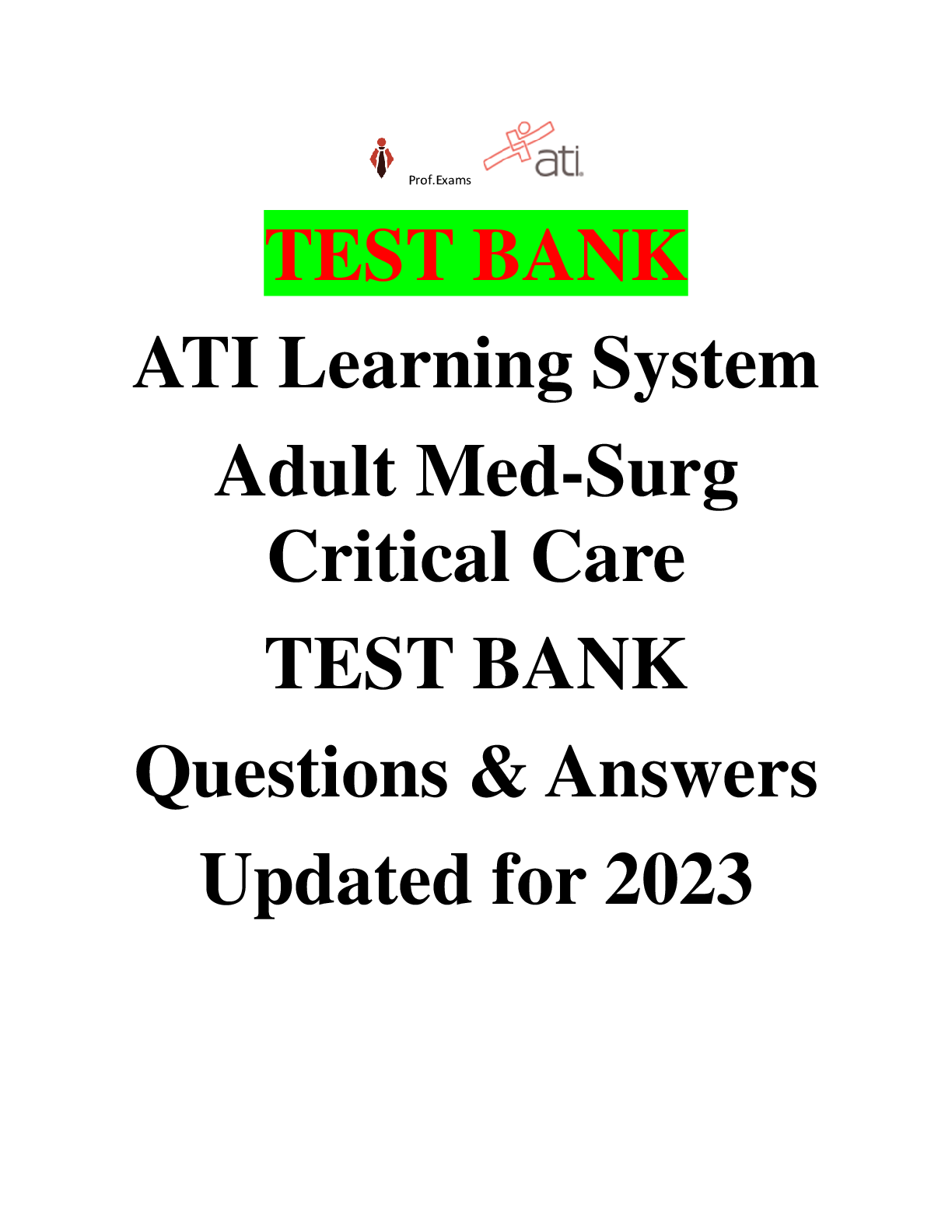
Buy this document to get the full access instantly
Instant Download Access after purchase
Buy NowInstant download
We Accept:

Reviews( 0 )
$26.00
Can't find what you want? Try our AI powered Search
Document information
Connected school, study & course
About the document
Uploaded On
May 17, 2023
Number of pages
143
Written in
Additional information
This document has been written for:
Uploaded
May 17, 2023
Downloads
0
Views
250




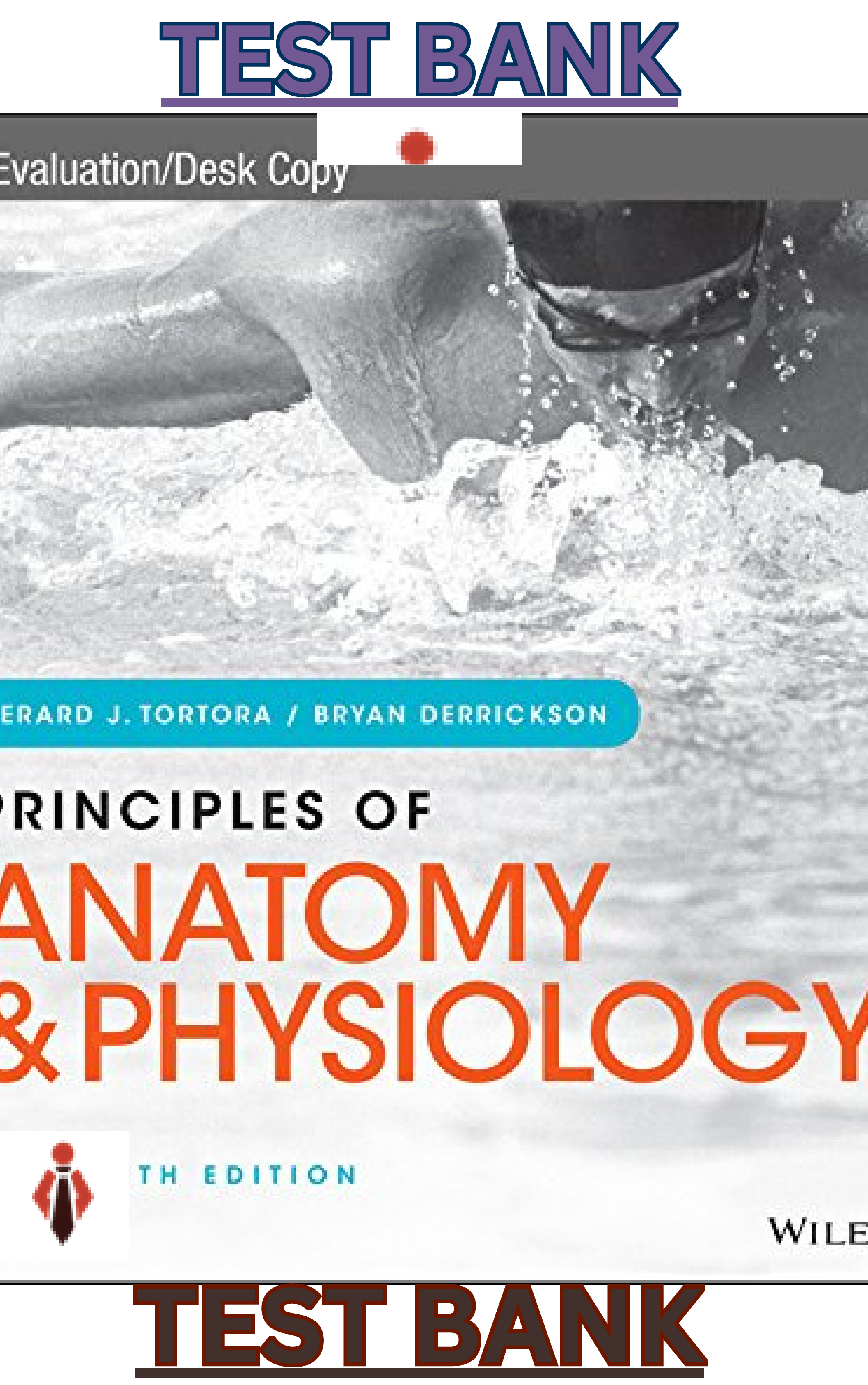

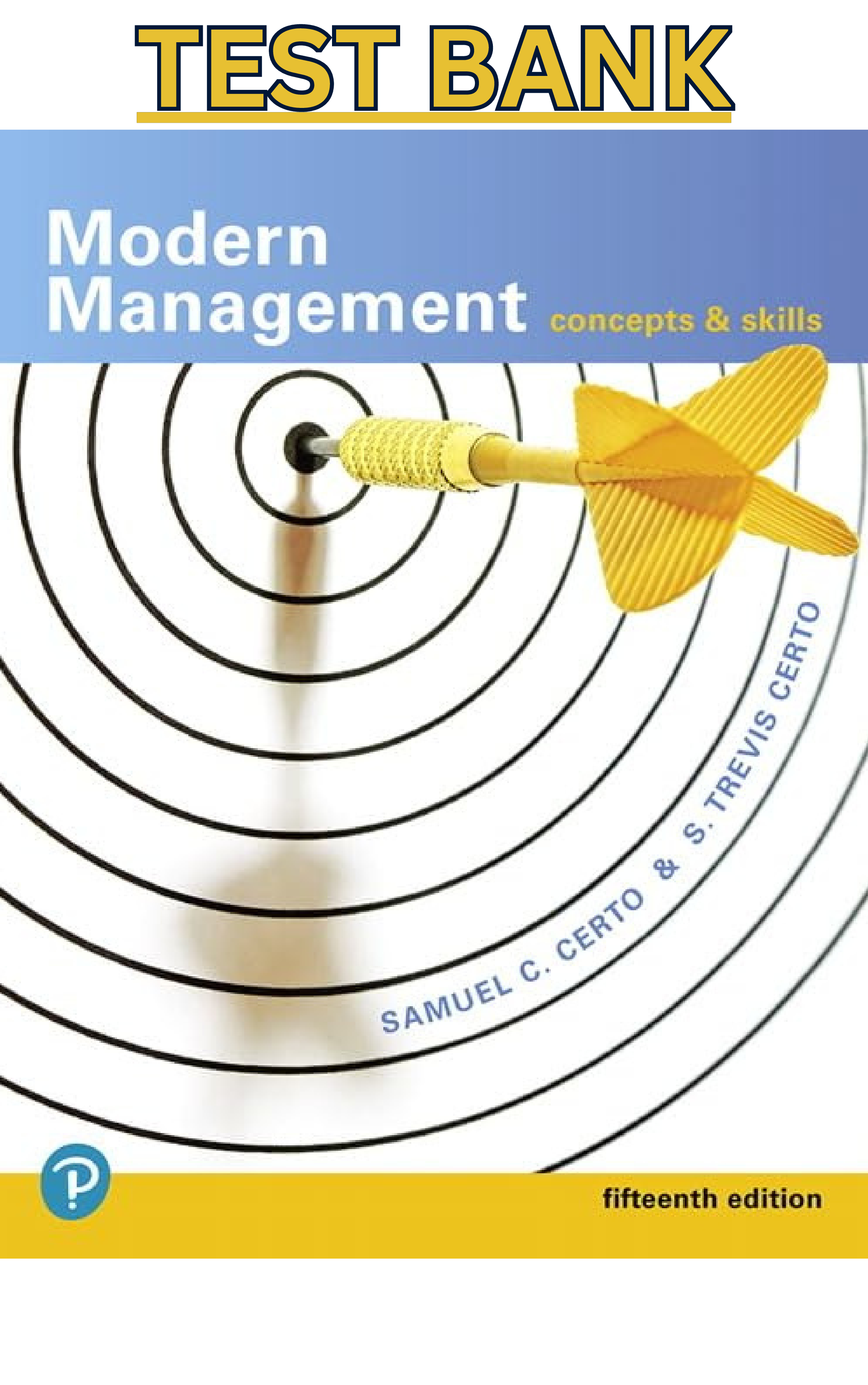
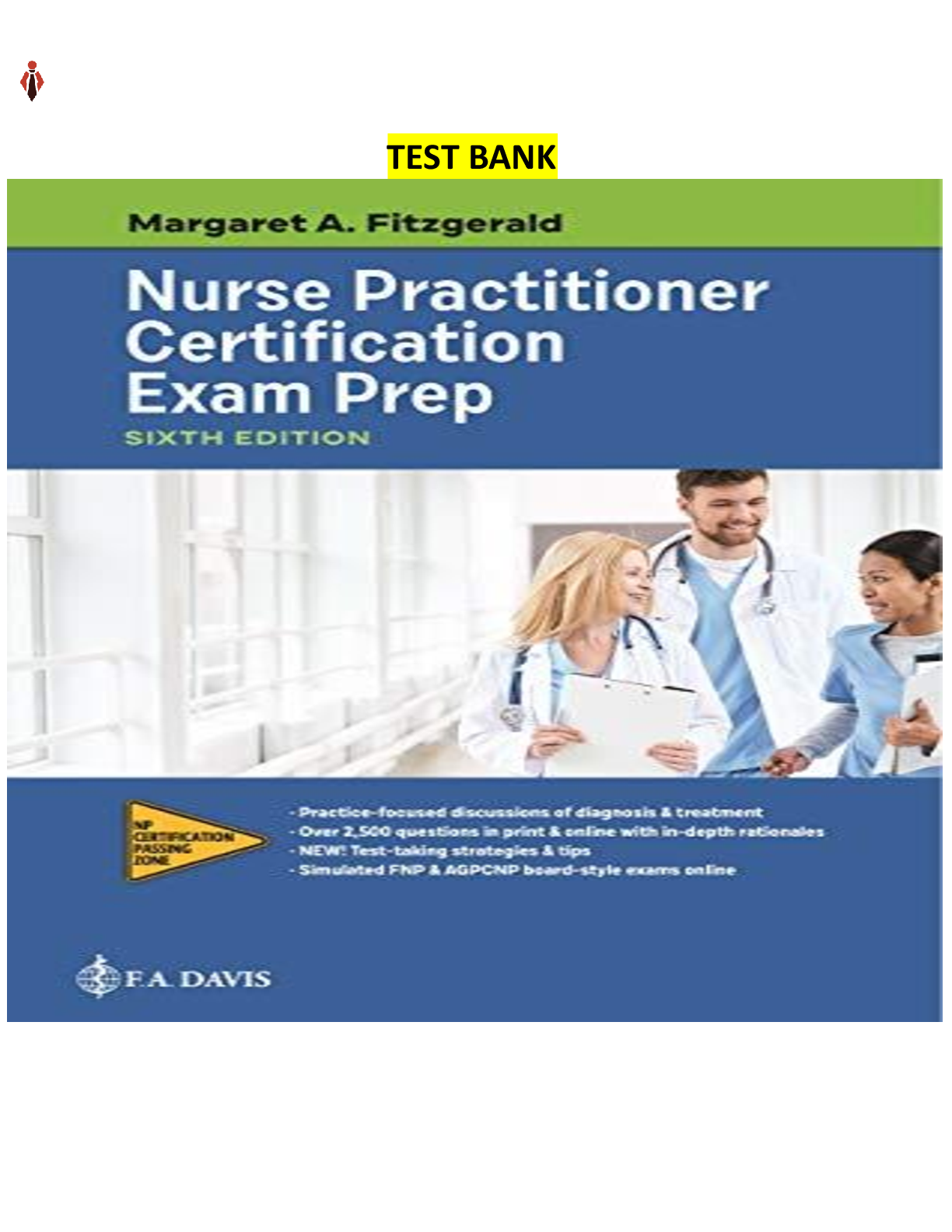






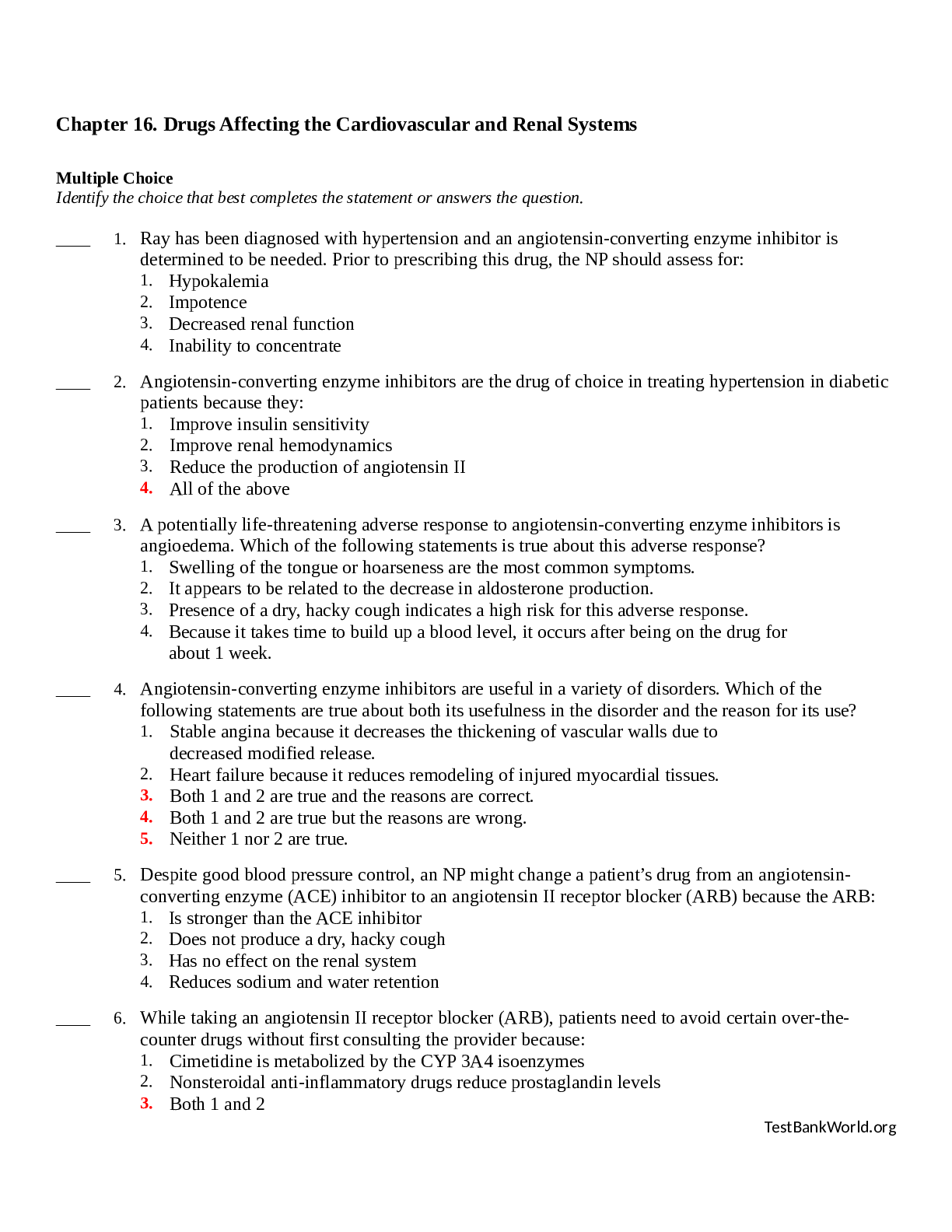
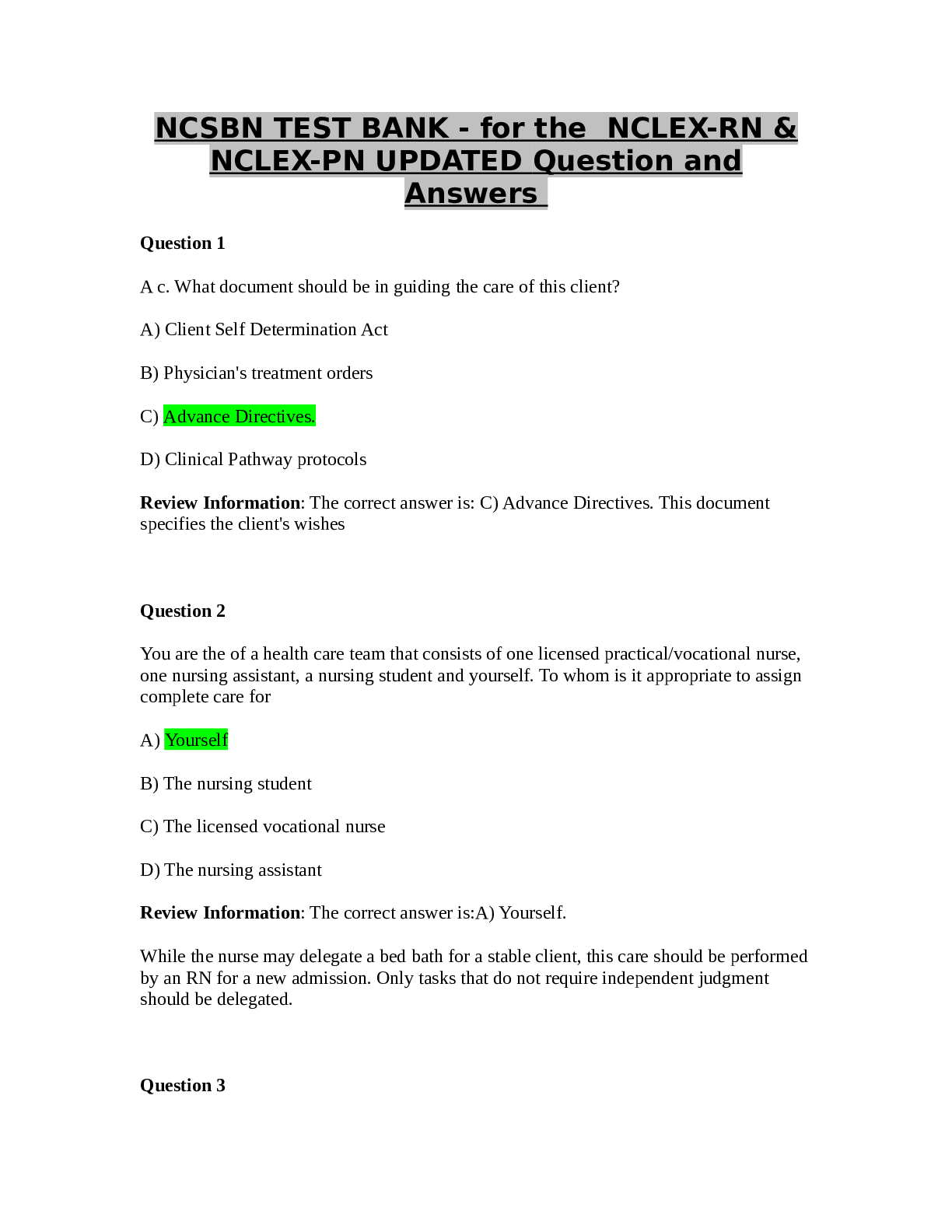

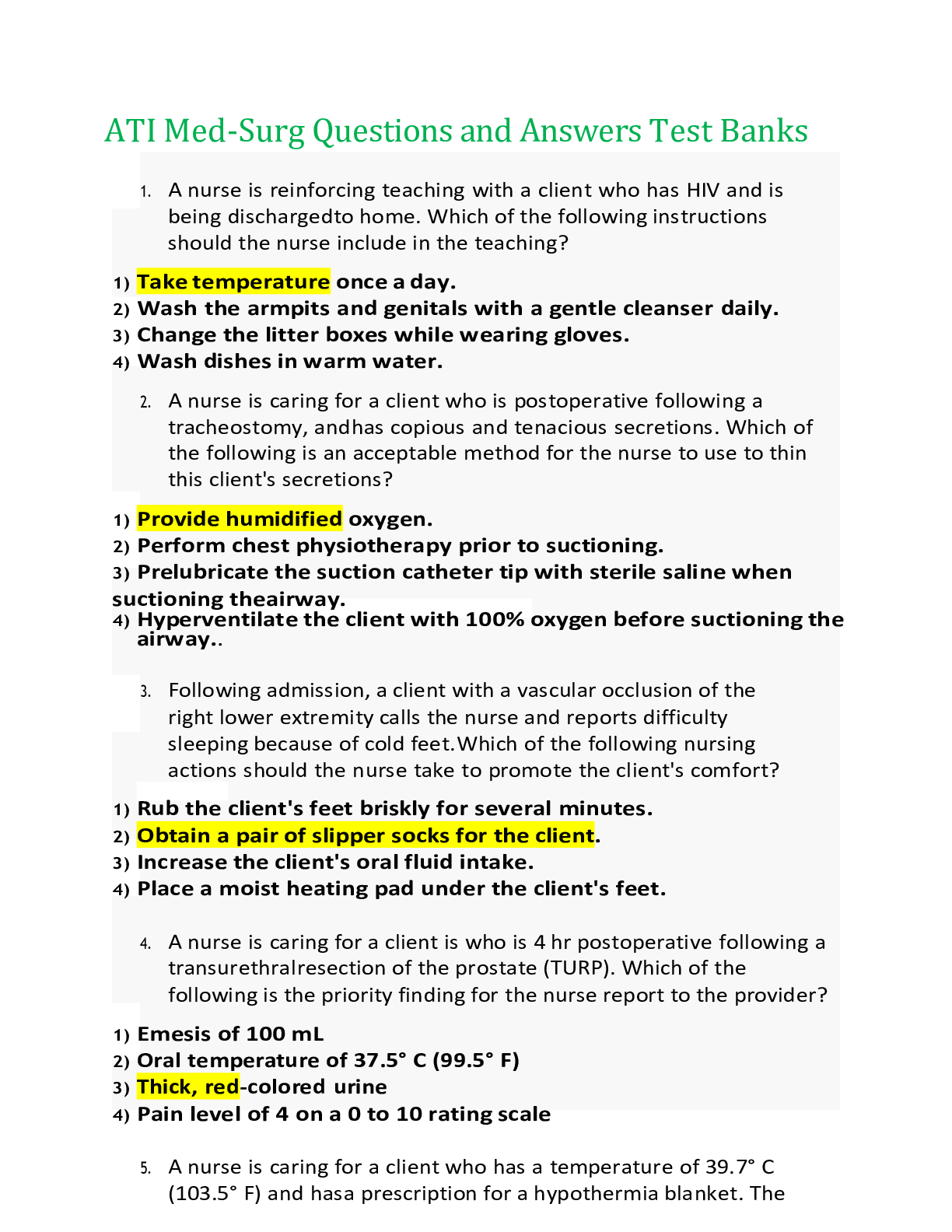
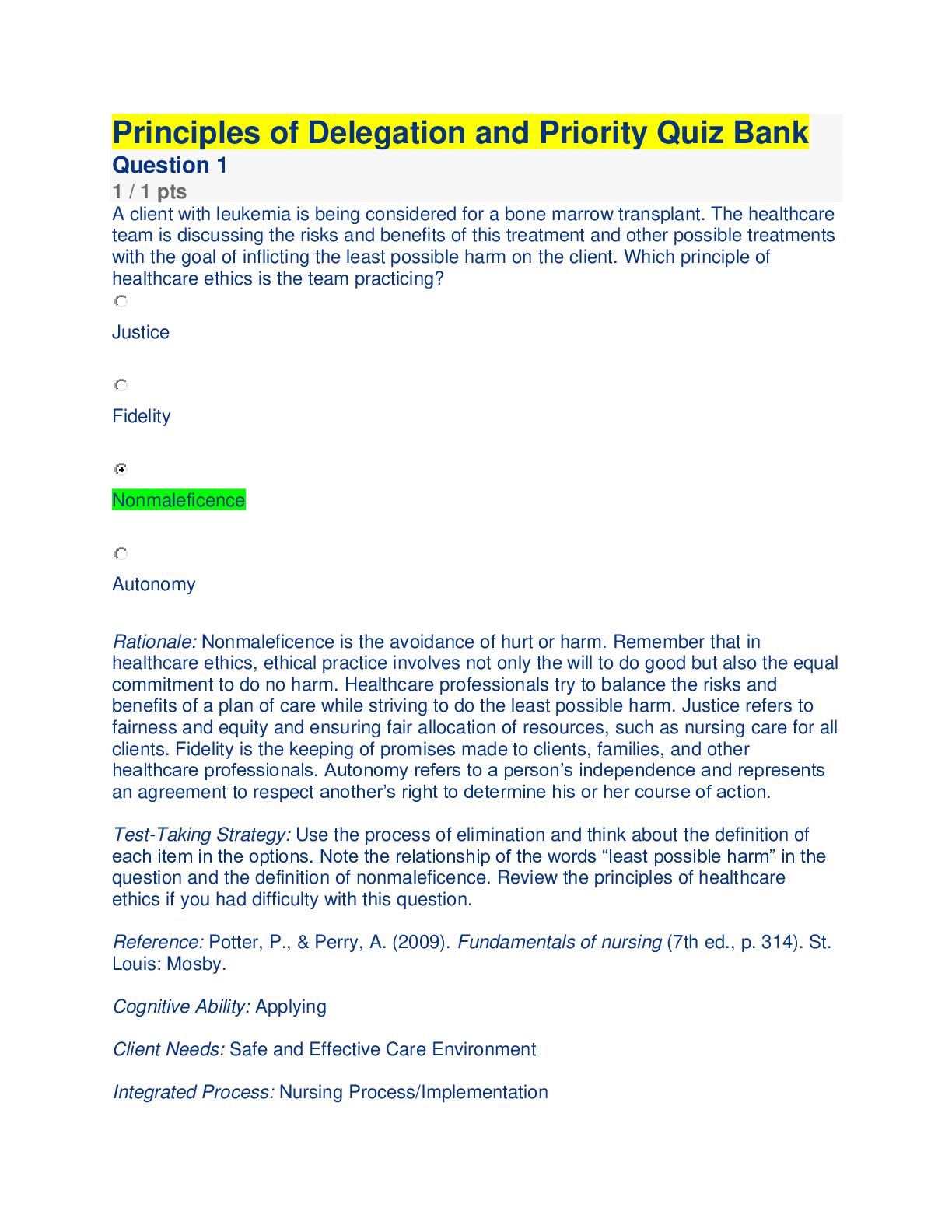

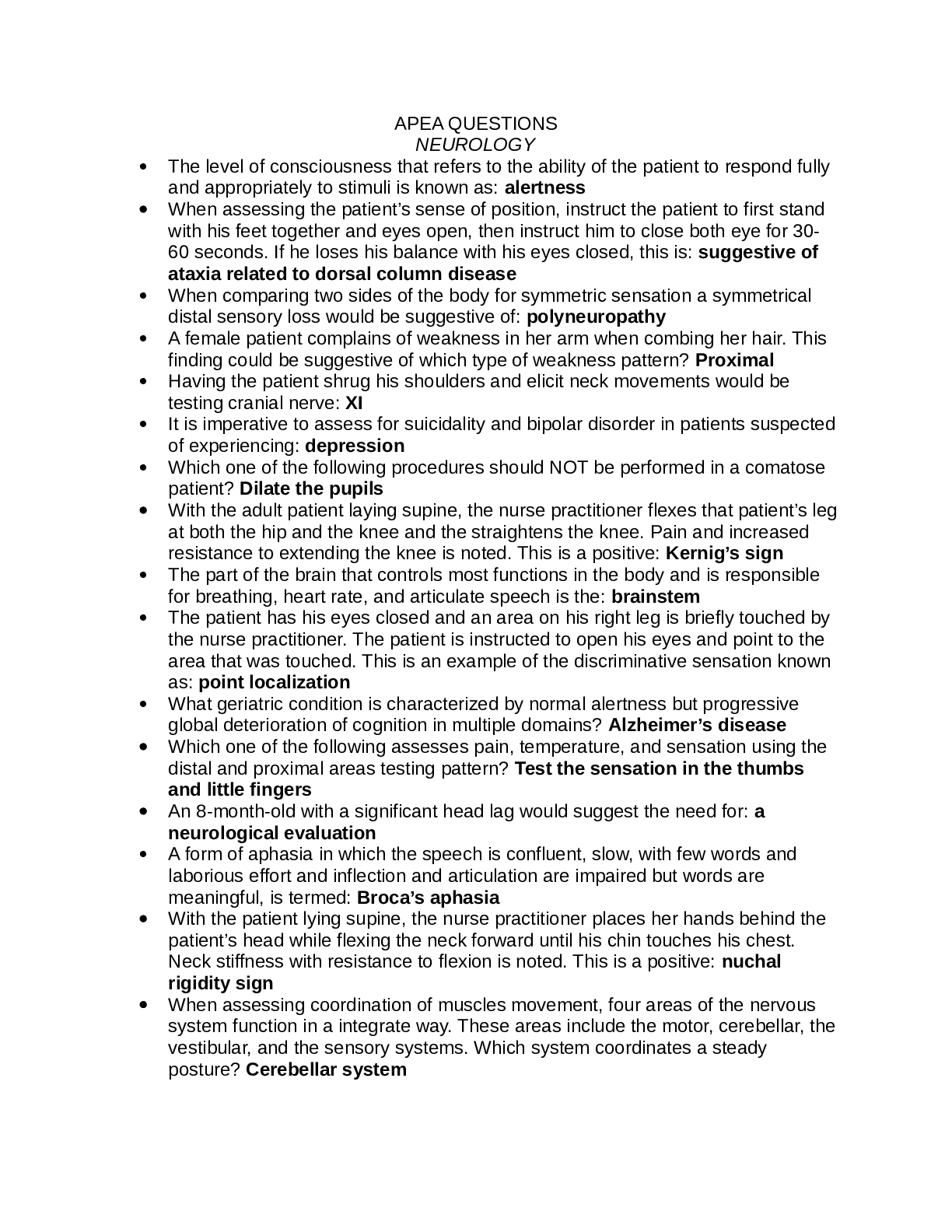

.png)



